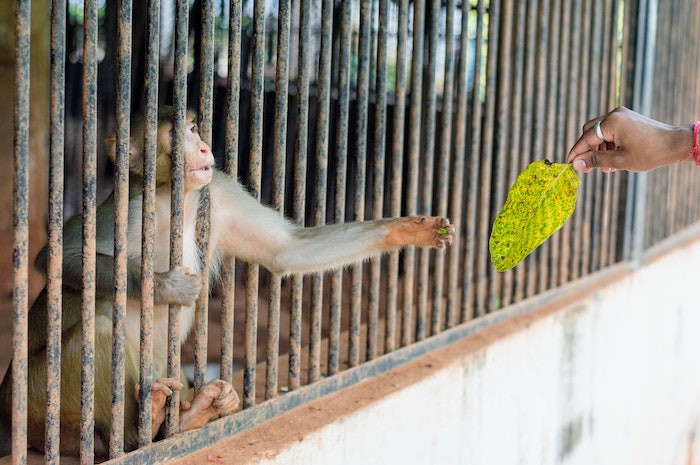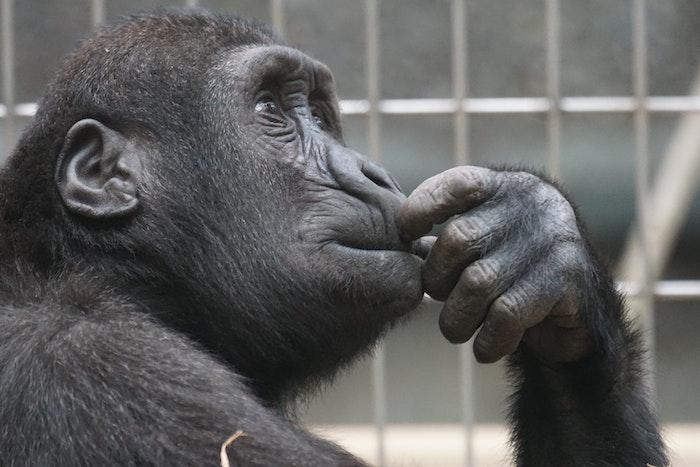Animal exploitation refers to the use of animals for human benefit in ways that cause them harm or suffering. This can take many forms, including using animals for food, clothing, entertainment, research, and experimentation.
In many cases, animals are treated as mere commodities, and their well-being and interests are disregarded in favor of human interests. This can result in conditions such as cramped living spaces, lack of access to food and water, and physical and psychological abuse.
Animal exploitation is a controversial issue, with some arguing that certain uses of animals, such as for medical research, are necessary for human progress and benefit, while others argue that all forms of animal use and abuse are unethical and should be eliminated.

How are animals exploited for entertainment?
Animals are often exploited for entertainment purposes in a variety of ways, including:
- Circuses: Many circuses feature wild animals such as elephants, tigers, and lions, who are trained to perform tricks and stunts. These animals are often forced to perform through physical punishment and deprivation of food and water.
- Zoos: While zoos are intended to educate and promote conservation, many animals in captivity suffer from cramped and unnatural living conditions, lack of stimulation, and limited social interaction.
- Rodeos: Rodeos often involve cruel practices such as bucking bronco events, calf roping, and bull riding. These activities can cause physical injuries and emotional distress to the animals involved.
- Aquariums: Similarly to zoos, many animals in aquariums are kept in small tanks that do not meet their natural needs. Some aquariums also engage in practices such as dolphin and whale shows, which can be physically and emotionally taxing on the animals.
- Dog and horse racing: In these sports, animals are often pushed to their physical limits, and injuries and even deaths can occur as a result.
Overall, the exploitation of animals for entertainment is a contentious issue, with many arguing that it is unethical to use animals in this way, while others defend certain forms of entertainment as being necessary for education and enjoyment.

What countries are the worst offenders of animal exploitation for entertainment?
It is difficult to definitively identify which countries are the “worst offenders” of animal exploitation for entertainment, as the practices and regulations vary widely between countries and regions. However, some countries and regions have come under criticism for their treatment of animals in entertainment.
For example, many countries in Asia have been criticized for their treatment of animals in circuses and other entertainment industries. In these countries, wild animals such as elephants, tigers, and monkeys are often trained through cruel methods such as physical abuse and deprivation of food and water.
Similarly, countries such as Spain and Mexico have been criticized for their treatment of animals in bullfighting, which involves physical abuse and killing of bulls for entertainment.
In the United States, there has been criticism of animal welfare standards in circuses and other entertainment industries, as well as in the horse and greyhound racing industries.
However, it is important to note that there are also many countries and regions where animal welfare standards are higher and animal exploitation for entertainment is either illegal or highly regulated.

What countries and regions have high standards?
There are several countries and regions that have high standards for animal welfare in entertainment industries. Some examples include:
- United Kingdom: The UK has some of the highest animal welfare standards in the world, and many forms of animal exploitation for entertainment, such as wild animal circuses, are banned.
- Scandinavia: Norway, Sweden, and Denmark have some of the highest animal welfare standards in the world, and there are strict regulations around animal use in entertainment.
- Australia and New Zealand: These countries have strong animal welfare regulations and standards, and many forms of animal exploitation for entertainment are either banned or highly regulated.
- Canada: Canada has a strong animal welfare framework and regulations around animal use in entertainment, including circuses and rodeos.
- European Union: The EU has some of the strongest animal welfare laws in the world, and there are regulations around animal use in entertainment throughout the member states.
While these countries and regions have higher standards for animal welfare in entertainment, there is still room for improvement and challenges to enforcing these standards.

How can you tell if an animal sanctuary or zoo does of not exploit animals?
It can be difficult to determine whether an animal sanctuary or zoo is exploiting animals or providing humane and ethical care. However, there are a few things you can look for when assessing an animal sanctuary or zoo:
- Size and quality of enclosures: Animals should be provided with adequate space and appropriate environmental conditions to meet their physical and behavioral needs. Look for enclosures that are spacious, clean, and well-maintained, with features such as natural vegetation, shade, and opportunities for social interaction.
- Treatment of animals: Observe how the animals are being treated. Are they showing signs of stress or fear? Are they being handled in a rough or aggressive manner? Are they being forced to perform or engage in activities that are not natural to their behavior?
- Conservation and education efforts: Many legitimate animal sanctuaries and zoos focus on conservation efforts and educational programs to help protect and preserve species in the wild. Look for organizations that have strong conservation and education programs, and are working to promote the well-being of animals both in captivity and in the wild.
- Accreditation: Look for organizations that have been accredited by reputable accrediting bodies such as the Association of Zoos and Aquariums (AZA) or the Global Federation of Animal Sanctuaries (GFAS). These organizations have strict standards for animal welfare, conservation efforts, and education programs.
- Transparency: A legitimate animal sanctuary or zoo should be transparent about its operations, including its funding sources, animal welfare practices, and conservation efforts. Look for organizations that are willing to share information about their operations and are open to visitor feedback and questions.
Overall, it’s important to do your research and ask questions when assessing an animal sanctuary or zoo. By looking for the above criteria and doing your due diligence, you can help ensure that the organization you are supporting is providing humane and ethical care to the animals in its care.

What attractions and tours are being called out?
There are several popular tourist attractions that have been called out for exploiting animals. Here are a few examples:
- Elephant rides: Many tourist destinations, particularly in Asia, offer elephant rides as a popular activity. However, elephants used for rides are often subjected to cruel training methods and suffer from injuries and health problems caused by carrying tourists on their backs.
- Tiger temples: In Thailand, there have been several tiger temples where tourists could take photos with tigers or even pet them. However, it has been reported that these tigers were drugged and often mistreated, leading to animal welfare concerns.
- Dolphin and whale shows: Some tourist destinations offer shows featuring dolphins and whales performing tricks for the entertainment of tourists. However, these animals are often held in captivity in small tanks that do not meet their physical or behavioral needs, and may suffer from stress and health problems.
- Dancing monkeys: In some parts of Asia, monkeys are trained to perform for tourists by wearing costumes and dancing. However, these monkeys are often subjected to cruel training methods and live in poor conditions.
- Bullfighting: Bullfighting is a popular tourist attraction in Spain and other countries, but it involves physical abuse and killing of bulls for entertainment, raising concerns about animal welfare.
It’s important to research and avoid tourist attractions that exploit animals, and instead support organizations and destinations that promote humane and ethical treatment of animals.

Organizations that are working to help exploited animals
There are several organizations that work to help exploited animals. Here are a few examples, along with a brief description of who they are and their website URLs:
- World Animal Protection: World Animal Protection is an international animal welfare organization that works to improve the lives of animals around the world. Their work includes efforts to end animal cruelty, improve animal welfare standards, and raise public awareness about animal welfare issues.
- The Humane Society of the United States: The Humane Society of the United States is a leading animal welfare organization in the United States that works to protect animals from cruelty, abuse, and neglect. Their work includes efforts to promote animal protection laws, provide care and rescue for animals in need, and advocate for improved animal welfare standards.
- International Fund for Animal Welfare: The International Fund for Animal Welfare is a global animal welfare organization that works to protect animals and their habitats around the world. Their work includes efforts to end animal cruelty and exploitation, rescue and rehabilitate animals in need, and advocate for stronger animal welfare policies.
- Animal Equality: Animal Equality is an international animal protection organization that works to promote veganism, end animal exploitation, and improve animal welfare standards. Their work includes undercover investigations, public outreach and education, and advocacy for stronger animal welfare laws.
- Wildlife Conservation Society: The Wildlife Conservation Society is a global organization that works to protect wildlife and their habitats around the world. Their work includes conservation research, habitat protection, and education and outreach efforts to promote sustainable conservation practices.
These organizations are just a few examples of the many organizations working to help exploited animals around the world.
Reviewed by: Tim Winter

Tim Winter has dedicated his writing and research efforts to animals and wildlife. He explores the globe and sees firsthand the negative impact humans have on the environment. Tim is dedicated to promoting responsible environmental stewardship. He holds a Bachelor of Science in Advertising from the University of Oregon School of Journalism and Communications.
